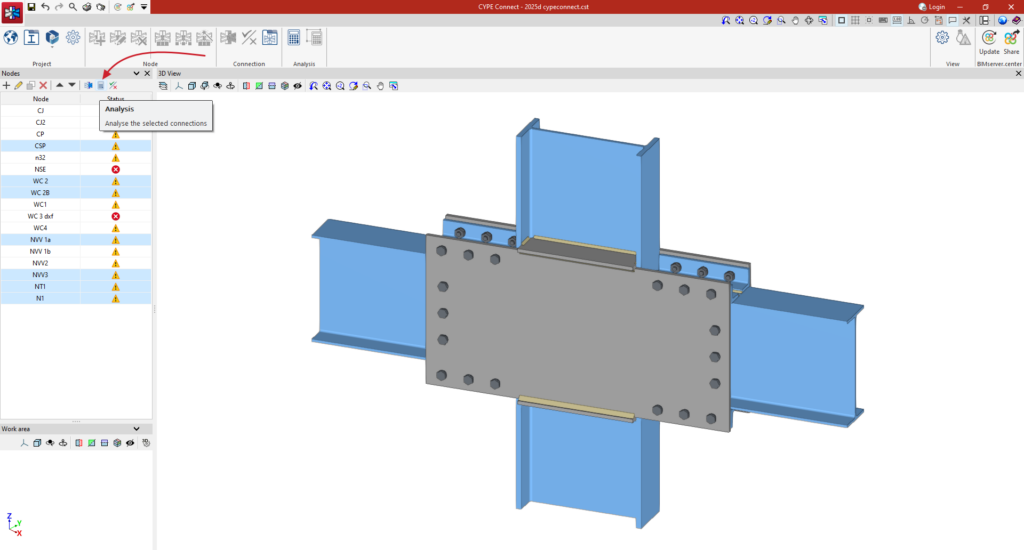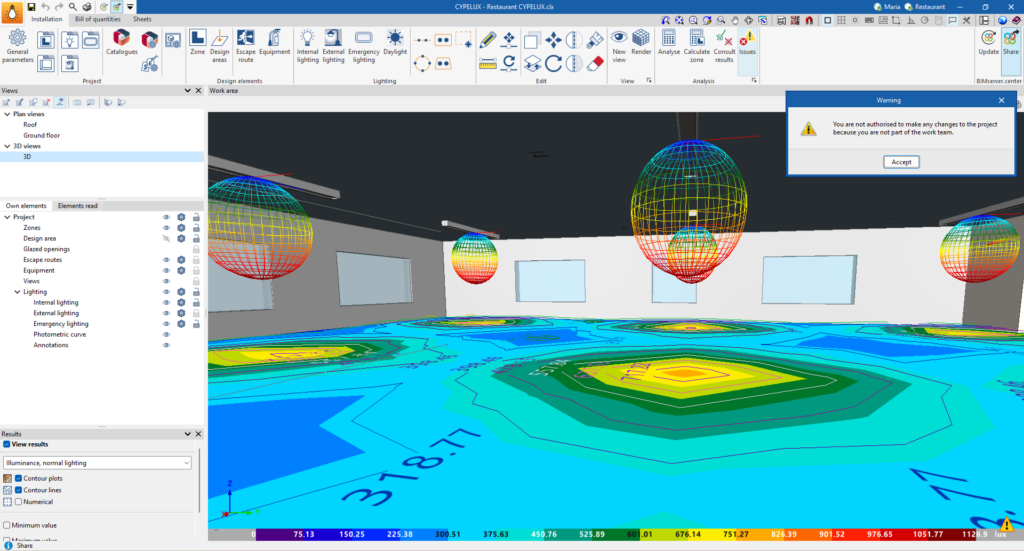Update history
CYPE Connect
Direct opening of projects with predetermined apps
As of version 2026.b, project files are automatically associated with the corresponding CYPE app in the Windows environment. This means that you simply double-click on the file to open it directly in the appropriate program, without having to select it manually. This improvement streamlines the workflow and provides a smoother and more efficient user experience.
- AcouBAT by CYPE, Arquimedes, Consoles curtos, Continuous beams, CYPE 3D, CYPE Accessibility, CYPE Architecture, CYPE Connect, CYPE Connect Classic, CYPE Construction Systems, CYPE Cost Estimator, CYPE Electrification, CYPE Gas Supply, CYPE Sewerage, CYPE Water Supply, CYPECAD, CYPECAD MEP, Cypedoc. Ficha técnica da habitação, CYPEFIRE, CYPEFIRE FDS, CYPEFIRE Hydraulic Systems, CYPEFIRE Pressure Systems, CYPEGAS, CYPEHVAC, CYPEHVAC Radiant Floor, CYPEHVAC Schematics, CYPELEC, CYPELEC Distribution, CYPELEC Electrical Mechanisms, CYPELEC MULTILINE, CYPELEC Networks, CYPELEC PV Systems, CYPELUX, CYPEPLUMBING, CYPESOUND, CYPETEL, CYPETEL Wireless, CYPETHERM BRIDGES, CYPETHERM EPlus, CYPETHERM HYGRO, CYPETHERM Improvements, CYPETHERM LOADS, Gerador de preços, Geradores de orçamentos, IFC Builder, Open BIM Analytical Model, Open BIM Cable Routing, Open BIM Layout, Open BIM Model Checker, Open BIM Quantities, Open BIM Site, Open BIM Switchboard, Pormenores construtivos, Portal frame generator, Pré-dimensionadores de medições e orçamentos, Punching shear verification, StruBIM Box Culverts, StruBIM Cantilever Walls, StruBIM Deep Beams, StruBIM Embedded Walls, StruBIM Shear Walls, StruBIM Steel
- Published on
- 2026.b
Design of connections with solid round bars in StruBIM Steel and CYPE Connect
The possibility of designing and checking connections with solid round bars has been incorporated into StruBIM Steel and CYPE Connect, expanding the range of structural types available.
- Published on
- 2026.b
Verification of partial penetration welds in StruBIM Steel and CYPE Connect
Weld verification in StruBIM Steel and CYPE Connect has been expanded to also cover partial penetration welds, in addition to fillet welds, in accordance with the selected standard.
- Published on
- 2026.b
Simplified insertion of bolts in StruBIM Steel and CYPE Connect
New options have been implemented in StruBIM Steel and CYPE Connect that allow the positions of bolts to be defined more quickly and easily, improving efficiency in the modelling of connections.
- Published on
- 2026.b
Multilingual export of reports in StruBIM Steel and CYPE Connect
The project reports can be exported in different languages, which makes it easier to manage projects in international environments.
- Published on
- 2026.b
Implementation of new international standards in CYPECAD, CYPE 3D, StruBIM Steel and CYPE Connect
Version 2026.b expands the international scope of CYPE software with the implementation of new standards:
-
- CYPECAD (Turkish wind standard TS 498: 2021);
-
- CYPECAD and CYPE 3D (Algerian earthquake standard RPA 2024);
-
- CYPECAD, CYPE 3D and Portal frame generator (Romanian rolled steel standard SR EN 1993-1-1);
-
- CYPECAD, CYPE 3D and Portal frame generator (Romanian standard SR EN 1993-1-3 and Indian standard IS 801 - 1975 (Rf 1995) for shaped steel);
-
- StruBIM Steel and CYPE Connect (Australian standards for anchors AS 3600: 2018 and AS 5216: 2021).
- Published on
- 2026.b
Prequalified connections in CYPE Connect and StruBIM Steel
As of version 2026.a, prequalified connections can be used and checked when designing connections in CYPE Connect and StruBIM Steel with the codes that enable the option.
Prequalified connections are required in structures where the seismic-resisting system consists of moment frames, particularly in the case of special moment frames (SMF) or intermediate moment frames (IMF), in accordance with AISC 341.
- Published on
- 2026.a
New features and improvements in StruBIM Steel and CYPE Connect
In version 2026.a, new features and improvements have been implemented in StruBIM Steel and CYPE Connect, including the ability to define extended holes, draw bolt forces and bar loads in contour plot views, and select the dimension to be tagged in fillet welds. In addition, performance improvements have been implemented to optimise the speed and smoothness of use, as well as a new warning for poorly defined welds. Finally, operations can now be selected when exporting welds to a library.
- Published on
- 2026.a
Importing CYPE 3D bars given a selection of tags
- Published on
- 2025.d
Tool for analysing the selected connections from the list of nodes
In version 2025.d, CYPE Connect incorporates a new tool for analysing selected connections directly from the list of nodes.
In previous versions, the program could analyse selected connections, but this selection had to be made exclusively from the 3D view of the structure.
Now with this update, the tool, located at the top of the list of connections, can be used to select and analyse connections directly from the list.
- Published on
- 2025.d
Checking permissions when sharing a contribution in the BIMserver.center project
As of version 2025.d, when clicking the "Share" option of the apps (before starting the generation of the contribution files), a check is made to ensure that the user is part of the BIMserver.center project team. If the user does not have the appropriate permissions, a warning message is displayed. This prevents the generation of unnecessary files when the user does not have editing rights.
- AcouBAT by CYPE, Arquimedes, CYPE 3D, CYPE Architecture, CYPE Connect, CYPE Connect Classic, CYPE Construction Systems, CYPE Cost Estimator, CYPE Gas Supply, CYPE Sewerage, CYPECAD, CYPEFIRE, CYPEFIRE FDS, CYPEFIRE Hydraulic Systems, CYPEFIRE Pressure Systems, CYPEHVAC Radiant Floor, CYPEHVAC Schematics, CYPELEC, CYPELEC Distribution, CYPELEC Electrical Mechanisms, CYPELEC MULTILINE, CYPELEC Networks, CYPELEC PV Systems, CYPELUX, CYPEPLUMBING, CYPESOUND, CYPETEL Wireless, CYPETHERM C.E., CYPETHERM EPlus, CYPETHERM LOADS, CYPEURBAN, IFC Builder, Open BIM Analytical Model, Open BIM Cable Routing, Open BIM Layout, Open BIM Model Checker, Open BIM Quantities, Open BIM Site, Open BIM Switchboard, Plugin Open BIM - Revit, Portal frame generator, StruBIM Box Culverts, StruBIM Cantilever Walls, StruBIM Deep Beams, StruBIM Embedded Walls, StruBIM Shear Walls, StruBIM Steel
- Published on
- 2025.d
BIMserver.center new features window
As of version 2025.d, the "Project selection" window in the apps connected to BIMserver.center incorporates a new notification system to inform users about the latest new features on the platform.
This space displays relevant messages about new features, enhancements and recommendations related to BIMserver.center. In addition, direct links to documents, tutorials and additional resources will be included to facilitate the adoption of these new features.
- AcouBAT by CYPE, Arquimedes, CYPE 3D, CYPE Architecture, CYPE Connect, CYPE Connect Classic, CYPE Construction Systems, CYPE Cost Estimator, CYPE Gas Supply, CYPE Sewerage, CYPECAD, CYPEFIRE, CYPEFIRE FDS, CYPEFIRE Hydraulic Systems, CYPEFIRE Pressure Systems, CYPEHVAC Radiant Floor, CYPEHVAC Schematics, CYPELEC, CYPELEC Distribution, CYPELEC Electrical Mechanisms, CYPELEC MULTILINE, CYPELEC Networks, CYPELEC PV Systems, CYPELUX, CYPEPLUMBING, CYPESOUND, CYPETEL Wireless, CYPETHERM C.E., CYPETHERM EPlus, CYPETHERM LOADS, CYPEURBAN, IFC Builder, Open BIM Analytical Model, Open BIM Cable Routing, Open BIM Layout, Open BIM Model Checker, Open BIM Quantities, Open BIM Site, Open BIM Switchboard, Plugin Open BIM - Revit, Portal frame generator, StruBIM Box Culverts, StruBIM Cantilever Walls, StruBIM Deep Beams, StruBIM Embedded Walls, StruBIM Shear Walls, StruBIM Steel
- Published on
- 2025.d





